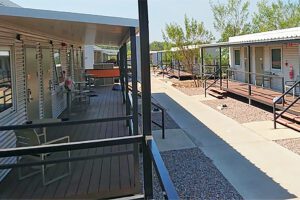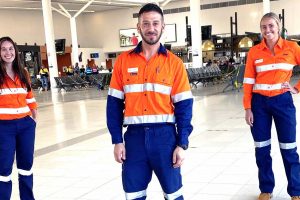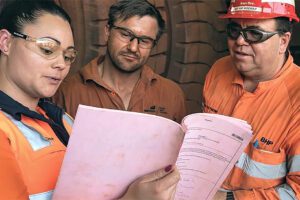KEEPING YOUR MATES SAFE IN TIMES OF CHANGE…ARE YOU WILLING TO BE THE CANARY IN THE COAL MINE FOR SAFETY SAKE?
Some time ago we spoke with Safety Psychologist David Broadbent. David shares with us the importance of taking personal responsibility for safety on mine sites and keeping everyone safe during times of unprecedented change.
David writes….When I was approached to write a piece on the place of personal safety within the minerals extraction space, it really got me thinking.
Firstly, personal responsibility for safety is a key weapon in the safety armoury. When properly implemented and integrated within an organisational safety system it can provide an enormous benefit to keeping our mates safe.
Having said that, personal safety as the only primary tool to combat accident/disaster outcomes shall always fail. It must be genuinely supported by partnering systems and appropriate safety leadership to be able to survive and thrive within what is an entropic system.
The fear that I have, is that in a rabid attempt to cut costs, the industry shall travel a bridge too far – I am seeing that already.
One global miner announced in late 2014 that it would be centrally managing all of its human resources (HR) operations from 2015 onwards. This has pretty much occurred – there is not a HR bod on-site, and they now get a ‘visit’ from a HR bod every week or so.
READ RELATED CONTENT
Do we truly believe that the critical role of human resources is just something that can be effectively managed by someone who is unknown to the local operation? Well it seems that some pretty important people do – important in that they have the control over these sorts of decisions.
My own opinion is that there shall be a consequence of this functional devaluation of people in the equation. This sort of behaviour flies in the face of known best practice.
David Broadbent
I am reminded of a meeting I had with a miner. They indicated to me that they had been present in a large meeting, with Rio Tinto CEO Sam Walsh at the helm.
Sam put to the group the question – what is our most valuable resource?
For the most part the bods in the room were saying things like “quality of ore base”, “life expectancy of the site”, “environmental footprint” – but nobody said what Sam was after. He told these guys the most valuable resource is “our people”. Sam and I are in complete agreement on this point – the most valuable resource is people.
Unfortunately, this view is not always being practiced. The most valued resource is the one which is being so quickly discarded, and in large numbers. There can be little doubt that this is going to have an impact on the underlying safety systems, and behaviours occurring throughout the industry.
For example, I happened to visit a mine site recently – this was a site operated by one of the top-tier mining houses. The site had been working through one of these cost-cutting drives since mid-2014.
As I am escorted to a work station for the day, one of the first things I notice is a piece of yellow sticky paper on the light switch as I enter the main room. It said ‘do not operate – will trip circuit’.
My host points me to a small office and suggests I use that room because the lights work. When I am in the room the lights decide to go out. There is not a general power failure – the lights just died. What do these observations tell us about the current safety culture on that site?
Then there is the question of providing psychological support to people who are in the midst of all this uncertainty. Many mine sites have Employee Assistance Programs (EAPs) and they should be commended for that intervention – these things save lives.
Yet, I have been seeing a truly concerning trend. Mine sites seeking out cheaper EAP providers. How do these few providers offer prices significantly less than the market? They do so by offering telephone counselling only.
Historically, confidential EAP services would be made available both on and off-site with a professional psychologist. The telephone was a tool of last resort. So, what we are increasingly seeing is that programs with a significant positive influence, and are supporting the psychological safety of our mine sites, are also being compromised.
This should be scary. At what point do these changes reach the tipping point, and move toward the realm of toxicity?
Now I can keep rabbiting on about these decisions, but what good will it do? What it does do though, is demonstrate the critical need to focus far more on our personal safety. In other words, what we need to be focussed on is keeping our mates safe.
There can be little doubt that the safety of operations is going to be compromised, as they seek to recalibrate to a significantly different operational space. I am sure it is politically incorrect to say things like this publicly.
When I have these sorts of discussions with mine managers, they almost always spruik the company line – “safety is our number one priority”. A little later we might be sharing a meal in the mess, and having a far more informal chat. In that environment they acknowledge the challenge being confronted, and can almost see the hypocrisy of their earlier comment.
Operational survival is the true number one priority – or that’s how it appears. Safety support systems are also being pared to the bone. Can you imagine a situation where you notice a potential site safety hazard and need to report it as the corporate procedure requires?
The superintendent is flat stick busy, the site safety adviser is now based in Melbourne, and your workplace is in the Hunter Valley. You report to the safety adviser in Melbourne, who says they shall deal with it straight away. They are also concurrently dealing with a request from an operation in the Surat Basin. For whatever reason, you are forgotten.
Now if you think I am being unnecessarily provocative, I’m sorry. Yet I can point you toward so many accidents/disasters where this is exactly the sort of thing that contributes to horrific outcomes.
One well-known Australian example is the Longford Gas Disaster. It was exactly these sorts of cost-cutting behaviours that are believed to have contributed to that explosion. So how do we keep people safe during these times of unprecedented organisational contraction?
The first thing we truly need to do is recognise that our remaining people must become the sentinels of the system – they must become the ‘canary’ in the mine. They must take personal responsibility for safety.
The canary in the coal mine for safety
You may recall that in days past, coal miners would take canaries down the tunnels with them as an early detection system against life-threatening gases, such as carbon dioxide, carbon monoxide and methane.
The canary, normally a very songful bird, would stop singing and eventually die if not removed from the presence of these gases. Now the canary’s respiratory system was far more sensitive than the guys in the mine. So when the bird went feathers up, you bolted for the cage and to the surface you went.
When I worked for Australia’s leading steel producer in the early 80s, we were still using the canary as a key element of our toxic gas detection program. In short, the canary was an early warning system. It was able to detect potentially harmful situations, prior to these becoming a problem, for the human workforce. So, how many canaries do you want in your workplace? In my view, as many as possible.
Consider this: As we reduce the number of ‘eyeballs’ within the operation, we are also reducing the potential levels of safety redundancy within the system. When we are thinking about these ‘eyeballs’ there are two aspects to consider – quality and quantity.
It stands to reason that if we are reducing the quantity, then we clearly have to increase the quality, if we are going to, at least, maintain the integrity of safety oversight. What that means is that we must actively encourage our people to chirp more often. But how do we achieve this?
This is quite a difficult transition, as it may require somewhat of a change in the mindset operating within the business. We must consider drawing upon one of the hallmarks of High Reliability Organising (HRO) – preoccupation with failure.
One of the most critical handbrakes slowing down the likelihood of an accident/disaster is maintaining a significant focus toward system deviation. These can be deviations within operations/procedures, and also people’s behaviour. Where we need to get to is a deep focus on when things are just beginning to be a little different, a little off.
We are not waiting for something to become ‘significant’, often by then the chain of events has already developed a life of its own and it is very difficult to terminate. The earlier your people can see these deviations the more likely a mild/moderate intervention can terminate the chain.
Now here’s where things can get a little more confusing. I have referred to the chain of events, and many shall be familiar with this analogy. The difficulty is that there is not one chain of events, there are multiple chains and they are, at times, interwoven.
In other words, people require some training in signal detection. Not only that, organisations need to be willing to listen to these people. Failure to genuinely do so is indicative of a toxic safety culture.
Many organisations place quite a bit of responsibility on their personal safety programs. They then do not properly respect the information that is flowing from these programs. It does not take that long for the workforce to realise that the reporting they are doing is not really resulting in anything, so what do they do? They stop reporting.
We call this ‘behavioural extinction’. For example, I recall a situation where there was a report of a process that resulted in heavy loads being transported overhead of a populated work area. The employees affected did the right thing and reported the hazard. Nothing appeared to happen, they became disillusioned and they stopped being concerned about safety – they developed the belief that the company was all hot air. This was not the case.
Due to the nature of the hazard, a significant engineering solution was required. The mistake this company made (and it was a big one) was not ensuring open lines of communication with the affected employees. They also did not include any of the affected employees on the solutions team. For the sake of a couple of very simple strategies, this company self-sabotaged their most effective incident warning system – their people.
The above example, or circumstances very similar to it, are depressingly too common. I am regularly called in to provide some insight into how a business can improve their personal safety systems. In almost all cases, the people in the business are actually keen to make a valued contribution to safety management.
The issue is, almost always, that the site safety management protocols do not effectively respect and regard the information coming from the workforce. In behavioural psychology we call this process ‘learned helplessness’. In essence, what is often found is a multi-tiered failure within what we might call ‘safety leadership’.
So how do we keep our mates safe in a multi-tiered changing environment?
Firstly, we need to ensure that the personal safety systems we have in place are appropriately resourced. This is of even greater importance in the current environment. We need to recognise that as the operational size is reduced we are also diminishing the effectiveness of those personal safety systems.
The operator that you just ‘let go’, might have been the next on the list, and thus they are gone. It just so happens that operator may have also been one of the safety champions in that crew. Ouch, that is going to hurt you. Often the people making those decisions have scant, if any, knowledge of these under the radar behaviours that are so important.
In addition, now is the time to truly invest in developing a consistent model of safety leadership within the business.
All of the contemporary safety research tells us that those organisations that have good safety leadership are far more likely to minimise their exposure to bad stuff. This is partly due to good safety leaders visibly and consistently respecting and regarding the information coming from all those canaries in the mine. Worth a thought?
The first thing we truly need to do is recognise that our remaining people must become the sentinels of the system – they must become the ‘canary’ in the mine
David Broadbent
DAVID G BROADBENT
David is a safety psychologist, specialising in trauma recovery, safety system development, organisational culture analysis and development, behavioural safety and multi-lingual safety systems.
He is also the founder of TransformationalSafety integrated safety culture and leadership assessment and development system.
Read more Mining Safety News














Add Comment